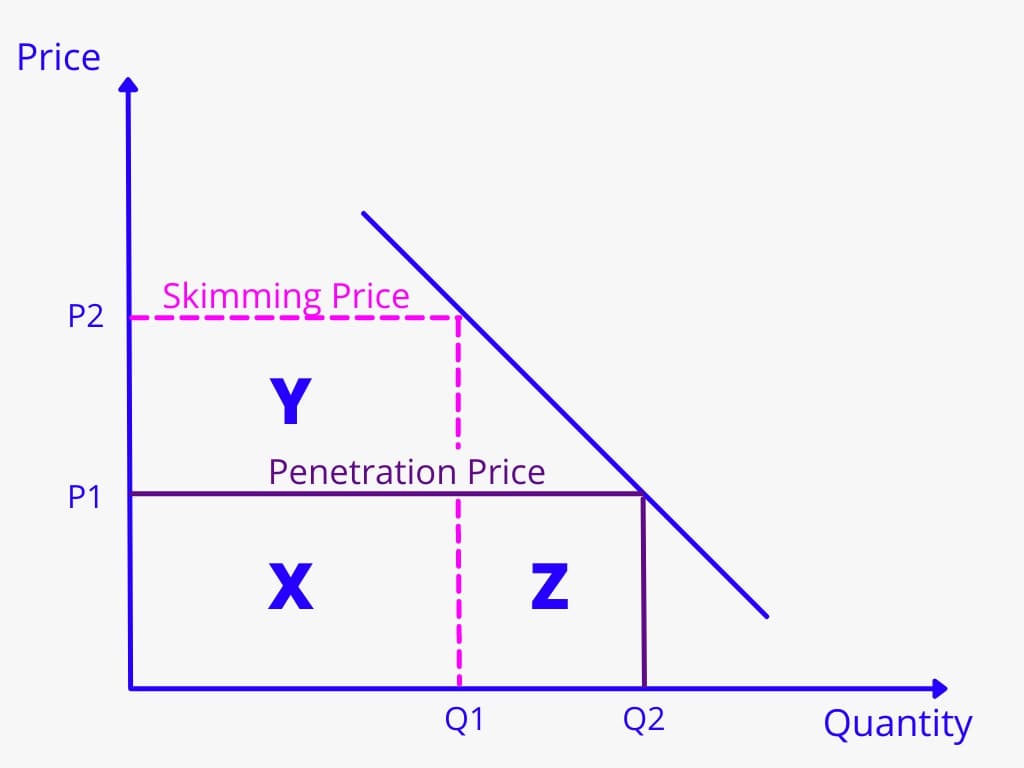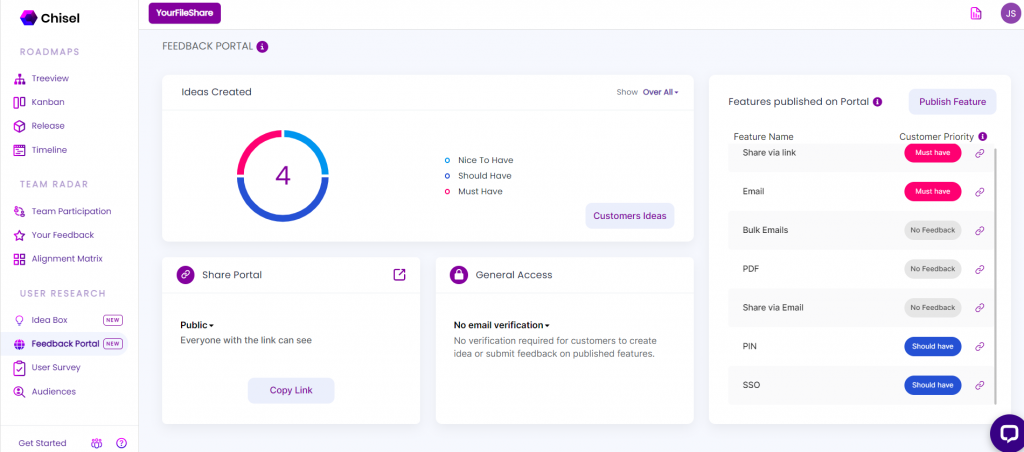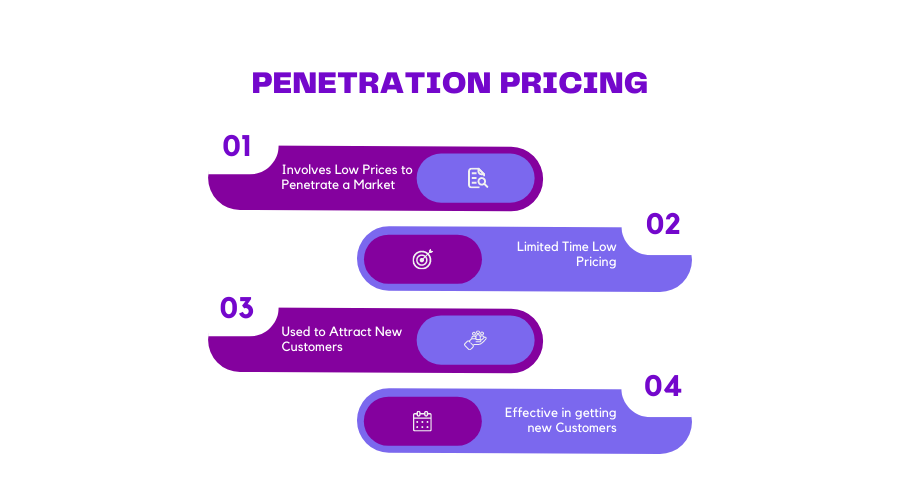Penetration Pricing: How does it work?
June 18, 2021 Max 6min read

Table of contents:-
- What is Penetration Pricing Strategy?
- Advantages of Penetration Pricing Strategy
- Disadvantages of Penetration Pricing Strategy
- Examples of Penetration Pricing Strategies
- How Does the Penetration Pricing Strategy Work?
- Penetration Pricing Strategy vs. Skimming Pricing
- Premium Pricing vs. Pricing Penetration Strategy
- FAQs
What is Penetration Pricing Strategy?
Penetration Pricing Definition
“Penetration pricing is a marketing strategy businesses employ to attract customers while launching new products or services in the market. The product’s lower price is offered, which helps it “penetrate” the market and appeal to the customers.”
Penetration pricing is a marketing strategy businesses employ to attract customers while launching new products or services in the market.
Here, you offer the product at a lower price which helps the product to “penetrate” the market and look appealing to the customers.
Companies use the penetration pricing strategy to garner a more significant chunk of the market audience and cut their competitors’ market share during the initial stages of the launch itself.
This way, when a large group of customers has tried their product, they may hike their prices and still keep most of those customers.
The companies must also ensure they have a clear roadmap for compensating for these low prices in the long term while employing this plan. If not, this oversight may come back to haunt them later.
With the help of product management tools like Chisel, you can create and manage product roadmaps.

Advantages of Penetration Pricing Strategy
- Penetration pricing strategy provides market dominance for a product at its initial stages. Naturally, customers are attracted to a product/service offered at a lower cost than its competitors. Suppose the product matches the customers’ expectations. In that case, they may even stick to it after the prices revert to their normal levels, which is the whole point of this strategy.
- Customers can find a bargain on a product they had been paying for heavily earlier. New businesses can build goodwill with many consumers by starting at lower, inexpensive prices. It helps create a positive atmosphere around the product and even increases customer loyalty.
One of the most effective ways to boost customer loyalty is by gathering customer feedback and ideas. Then, implement them into your product or service.

- The penetration pricing strategy requires a high sales quantity, enabling a firm to realize economies of scale and keep a check on its marginal costs.
Disadvantages of Penetration Pricing Strategy
- Customers may expect low prices permanently. Hence, when the business eventually decides to return to the typical costs of the products, the customers could be dissatisfied. And as a result, stop purchasing the product.
- The penetration pricing strategy demands a lot of customer loyalty, which can be very difficult in the current market. The market penetration pricing is more likely to attract bargain hunters who may switch to any better deal than they get from any of the competitors in the market.
- Low prices could make the customers assume the brand is cheap or low quality. Such an assumption could hamper the brand’s image significantly, making it harder to compensate for the initial low prices in the future.
Examples of Penetration Pricing Strategies
The perfect example of penetration pricing done right is Netflix.
For every new subscriber, Netflix initially provided a one-month free subscription to try out all the content on the platform.
Once users get hooked to the forum, they are more likely to pay for the coming months rather than miss out on the many series available.
Many other OTT platforms also deployed this strategy later to attract new customers.
Another great example could be comparing two smartphone companies like Apple and Samsung. Apple offers high prices while introducing its new products.
Over the years, due to a significant increase in the brand loyalty of Apple, its customers believe that its products are of high quality with better features. Thus they are willing to pay for them.
On the other hand, Samsung offers comparatively much lower prices for Android phones.
It also partners with cell phone companies and offers attractive discounts on its products in exchange for long-term commitments, hoping to build strong brand loyalty.
These low prices entice customers, which is why, while Apple sells expensive products to a smaller section of the market, Samsung sells cheaper phones. And Samsung caters to a much broader consumer base.
How Does the Penetration Pricing Strategy Work?
Penetration pricing is a market strategy sometimes used by new companies to attract the new and vast majority of customers.
The market penetration pricing takes advantage of the existing markets as the pricing is usually marked cheaper than the market price.
- It usually works during the introductory phase of the product life cycle when companies launch any innovative product or service.
- Prices get intentionally set low so that customers try the product/service.
- Competitors, in this case, do not get ample time to respond, which enables the company to acquire a considerable chunk of market share and establish itself as a new standard choice.
- The strategy is made such that the product’s sales volume compensates for the lower set prices.

Penetration Pricing Strategy vs. Skimming Pricing
Definition
Penetration pricing is a product pricing strategy where the introductory pricing of a high-quality product is marked low to penetrate the market and gain a significant market share.
Skimming pricing is a pricing strategy that sets the introductory prices high to earn maximum profit from product sales.
Aim
Penetration pricing aims to gain a considerable market share and lure customers, which you can achieve by offering competitive pricing.
However, a skimming pricing strategy aims to maximize profit, which you can achieve by marking products at higher prices.
Profit
Since the prices are marked lower in penetration pricing, and that is why the profit margin is usually low in the beginning.
However, in skimming pricing, the prices are marked up much higher. That is why the profit collection is usually pretty high.
When Applied
The penetration pricing method is generally applied when the product’s demand is elastic.
However, skimming pricing is generally applied when demand is inelastic.
Quantity of Sales
The amount of sales in the case of penetration pricing is relatively high, and the reason is simply that the prices are marked low.
However, in the case of skimming pricing, the quantity is a little low because the pricing is much higher.
Premium Pricing vs. Pricing Penetration Strategy
Definition
Premium pricing is a pricing strategy where the product price reflects its value. In this pricing strategy, the producers charge high fees for their products to provide high quality and perceived value.
The premium pricing strategy seeks to create a good image for the development. It does not matter whether the product’s price is way more than the competitors’ price.
The penetration pricing strategy is where the producers charge low prices for their products to penetrate the market and get more customers. It seeks to attract new customers and increase market share.
Type of Products
Premium pricing strategy: Premium pricing strategies gets commonly used for luxury goods such as cars or clothes.
Penetration pricing strategy: Penetration pricing is for essential commodities such as pharmaceuticals, mobile phones, and so on.
How Do They Help Companies?
Suppose premium pricing is used consistently through all the product life cycle stages. In that case, it will increase profit margins or promote customer loyalty.
On the other hand, a penetration pricing strategy will always result in lower profit margins. Still, it can lead to its rapid growth.
Bonus: Click here to learn in and out about product lifecycle.
Benefits
Premium pricing benefits:
- Premium prices can help produce high-quality products.
- Premium prices allow producers to cover their financial and non-financial costs.
- Premium pricing, in most cases, is a strategy that helps build lifelong customer relationships.
Penetration pricing benefits:
- Penetration pricing allows companies to be more flexible when it comes to pricing.
- You can use penetration pricing to create a competitive advantage.
- In most cases, companies that use market penetration pricing experience fewer risks when they start this strategy.
Bonus: Interested in learning more about competitive landscape analysis? Then why wait? Click here.
FAQs
Market penetration strategy is a strategy employed by businesses to gain a more significant share of the market than it currently has. You could do this through multiple paths such as better pricing, distribution, or research.
A market penetration strategy is employed by a business to increase its consumer base in the market, expand to new locations or improve its products. A penetration pricing strategy may be a part of this market penetration strategy to attract new customers by offering them lower prices or discounts.
